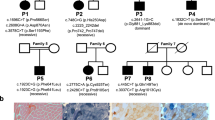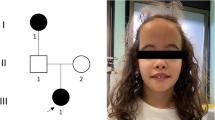Abstract
Prader–Willi syndrome (PWS) is associated with paternally derived chromosomal deletions in region 15q11–13 or with maternal disomy for chromosome 15. Therefore, loss of the expressed paternal alleles of maternally imprinted genes must be responsible for the PWS phenotype. We have mapped the gene encoding the small nuclear RNA associated polypeptide SmN (SNRPN) to human chromosome 15q12 and a processed pseudogene SNRPNP1 to chromosome region 6pter–p21. Furthermore, SNRPN was mapped to the minimal deletion interval that is critical for PWS. The fact that the mouse Snrpn gene is maternally imprinted in brain suggests that loss of the paternally derived SNRPN allele may be involved in the PWS phenotype.
This is a preview of subscription content, access via your institution
Access options
Subscribe to this journal
Receive 12 print issues and online access
$209.00 per year
only $17.42 per issue
Buy this article
- Purchase on Springer Link
- Instant access to full article PDF
Prices may be subject to local taxes which are calculated during checkout
Similar content being viewed by others
References
Prader, A., Labhart, A. & Willi, H., Syndrom von Adipositas, Kleinwuchs, Kryptorchidismus und Oligophrenie nach myotonie-artigem Zustand in Neugeborenalter. Schweiz. Med. Wochenschr. 86, 1260–1261 (1956).
Ledbetter, D.H. et al. Deletion of chromosome 15 as a cause of the Prader-Willi syndrome. New Engl. J. Med. 304, 325–329 (1981).
Butler, M.G., Meaney, F.J. & Palmer, C.G. Clinical and cytogenetic survey of 39 individuals with Prader-Labhart-Willi syndrome. Am. J. med. Genet. 23, 793–809 (1986).
Butler, M.G. Prader-Willi syndrome: Current understanding of cause and diagnosis. Am. J. med. Genet. 35, 319–335 (1990).
Magenis, R.E. et al. Comparison of the 15q deletions in Prader-Willi and Angelman syndromes: Specific regions, extent of deletions, parental origin, and clinical consequences. Am. J. med. Genet. 35, 333–349 (1990).
Nicholls, R.D., Knoll, J.H.M., Butler, M.G., Karam, S. & Lalande, M. Genetic imprinting suggested by maternal heterodisomy in non-deletion Prader-Willi syndrome. Nature 342, 281–285 (1989).
Mascari, M.J. et al. The frequency of uniparental disomy in Prader-Willi Syndrome. Implications for molecular diagnosis. N. Engl. J. Med. 326, 1599–1607 (1992).
Magenis, R.E., Brown, M.G., Lacy, D.A., Budden, S. & LaFranchi, S. Is Angelman syndrome an alternate result of del(15)(q11q13)? Am. J. med. Genet 28, 829–838 (1987).
Malcolm, S. et al. Uniparental paternal disomy in Angelman's syndrome. Lancet 337, 694–697 (1991).
Wagstaff, J. et al. Maternal but not paternal transmission of 15q11-13-linked nondeletion Angelman syndrome leads to phenotypic expression. Nature Genet. 1, 291–294 (1992).
Kuwano, A. et al. Molecular dissection of the Prader-Willi/Angelman syndrome region (15q11-13) by YAC cloning and FISH analysis. Hum. molec. Genet 1, 417–425 (1992).
Guthrie, C. Messenger RNA splicing in yeast: Clues to why the spliceosome is a ribonucleoprotein. Science 253, 157–163 (1991).
McAllister, G., Amara, S.G. & Lerner, M.R. Tissue-specific expression and cDNA cloning of small nuclear ribonucleoprotein-associated polypeptide N. Proc. natn. Acad. Sci. U.S.A. 85, 5296–5300 (1988).
Li, S., Klein, E.S., Russo, A.F., Simmons, D.M. & Rosenfeld, M.G. Isolation of cDNA clones encoding small nuclear ribonucleoparticle-associated proteins with different tissue specificities. Proc. natn. Acad. Sci. U.S.A. 86, 9778–9782 (1989).
Schmauss, C., McAllister, G., Ohosone, Y., Hardin, J.A. & Lerner, M.R. A comparison of snRNP-associated Sm-autoantigens: Human N, rat N and human B/B'. Nucl. Acids Res. 17, 1733–1743 (1989).
McAllister, G., Roby-Shemkovitz, A., Amara, S.G. & Lerner, M.R. cDNA sequence of the rat U snRNP-associated protein N: Description of a potential Sm epitope. EMBO J. 8, 1177–1181 (1989).
Schmauss, C. & Lerner, M.R. The closely related small nuclear ribonucleoprotein polypeptides N and B/B' are distinguishable by antibodies as well as by differences in their mRNAs and gene structures. J. biol. Chem. 265, 10733–10739 (1990).
Schmauss, C., Brines, M.L. & Lerner, M.R. The gene encoding the small nuclear ribonucleoprotein-associated protein N is expressed at high levels in neurons. J. biol. Chem. 267, 8521–8529 (1992).
Sharpe, N.G., Williams, D.G. & Latchman, D.S. Regulated expression of the small nuclear ribonucleoprotein particle protein SmN in embryonic stem cell differentiation. Molec. cell Biol. 10, 6817–6820 (1990).
Sundaresan, S. & Francke, U. Genes for β2-adrenergic receptor and the platelet-derived growth factor receptor map to mouse chromosome 18. Somat. Cell molec. Genet. 15, 367–371 (1989).
Chaillet, J.R. et al. The syntenic relationship between the critical deletion region for the Prader-Willi/Angelman syndromes and proximal mouse chromosome 7. Genomics 11, 773–776 (1991).
Left, S.E. et al. Maternal imprinting of the mouse Snrpn gene and conserved linkage homology with the human Prader-Willi syndrome region. Nature Genetics 2, 259–264 (1992).
Robinson, W.P. et al. Molecular, cytogenetic and clinical investigations of Prader-Willi syndrome patients. Am. J. hum. Genet. 49, 1219–1234 (1991).
Hamabe, J.-i., Kuroki, Y. & Imaizumi, K. DNA deletion and its parental origin in Angelman syndrome patients. Am. J. med. Genet. 41, 64–68 (1991).
Saitoh, S. et al. Familial Angelman syndrome caused by imprinted submicroscopic deletion encompassing GABAA receptor β3 subunit gene. Lancet 339, 366–367 (1992).
Wagstaff, J. et al. Localization of the gene encoding the GABAA receptor β3 subunit to the Angelman/Prader-Willi region of human chromosome 15. Am. J. hum. Genet. 49, 330–337 (1991).
Donlon, T. Report of the first international workshop on human chromosome 15 (1992). Cytogenet. Cell Genet. (in the press).
Zhang, Y. & Tycko, B. Monoallelic expression of the human H19 gene. Nature Genet. 1, 40–44 (1992).
Bartolomei, M.S., Zemel, S. & Tilghman, S.M. Parental imprinting of the mouse H19 gene. Nature 351, 153–155 (1991).
Rokeach, L.A., Jannatipour, M., Haselby, J.A. & Hoch, S.O. Primary structure of a human small nuclear ribonucleoprotein polypeptide as deduced by cDNA analysis. J. Biol. Chem. 264, 5024–5030 (1989).
Francke, U., Yang-Feng, T.L., Brissenden, J.E. & Ullrich, A. Chromosomal mapping of genes involved in growth control. In Molecular Biology of Homo Sapiens, Cold Spring Harbor Symp. Quant. Biol. 51, 855–866 (1986).
Oliver, N., Francke, U. & Pellegrino, M.A. Regional assignment of genes for mannose phosphate isomerase, pyruvate kinase-3 and β2-microglobulin expression on human chromosome 15 by hybridization of cells from at(15;22) (q14;q13.3). translocation carrier. Cytogenet. Cell Genet. 22, 506–510 (1978).
Francke, U. & Pellegrino, M.A. Assignment of the major histocompatibility complex to a region of the short arm of human chromosome 6. Proc. natn. Acad. Sci. U.S.A. 74, 1147–1151 and 5776 (1977).
Barton, D.E., Yang-Feng, T.L. & Francke, U. The human tyrosine aminotransferase gene mapped to the long arm of chromosome 16 (region 16q22-q24) by somatic cell hybrid analysis and in situ hybridization. Hum. Genet. 72, 221–224 (1986).
Author information
Authors and Affiliations
Rights and permissions
About this article
Cite this article
Özçelik, T., Leff, S., Robinson, W. et al. Small nuclear ribonucleoprotein polypeptide N (SNRPN), an expressed gene in the Prader–Willi syndrome critical region. Nat Genet 2, 265–269 (1992). https://doi.org/10.1038/ng1292-265
Received:
Accepted:
Issue Date:
DOI: https://doi.org/10.1038/ng1292-265
This article is cited by
-
Neural EGFL-like 1, a craniosynostosis-related osteochondrogenic molecule, strikingly associates with neurodevelopmental pathologies
Cell & Bioscience (2023)
-
Epigenetic modifications at DMRs of placental genes are subjected to variations in normal gestation, pathological conditions and folate supplementation
Scientific Reports (2017)
-
Porcine circovirus type 2 ORF4 protein binds heavy chain ferritin
Journal of Biosciences (2015)



